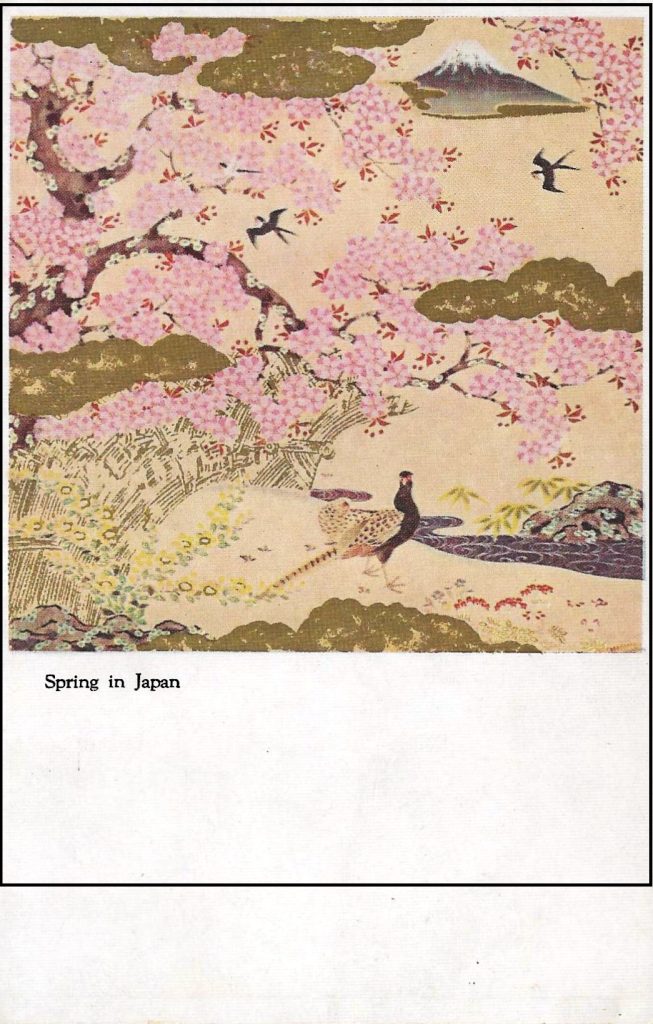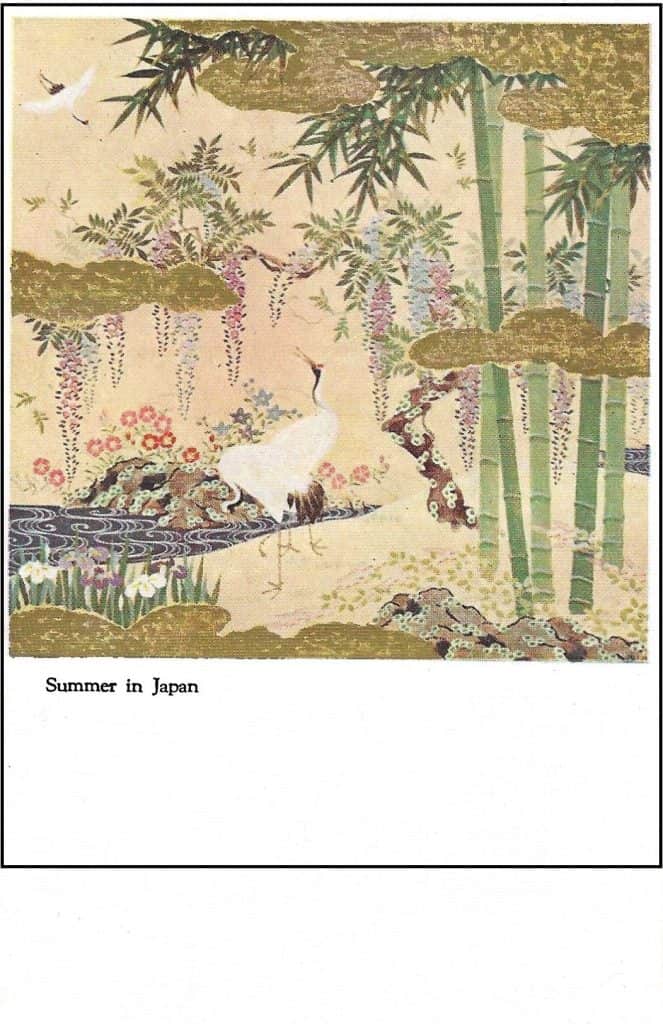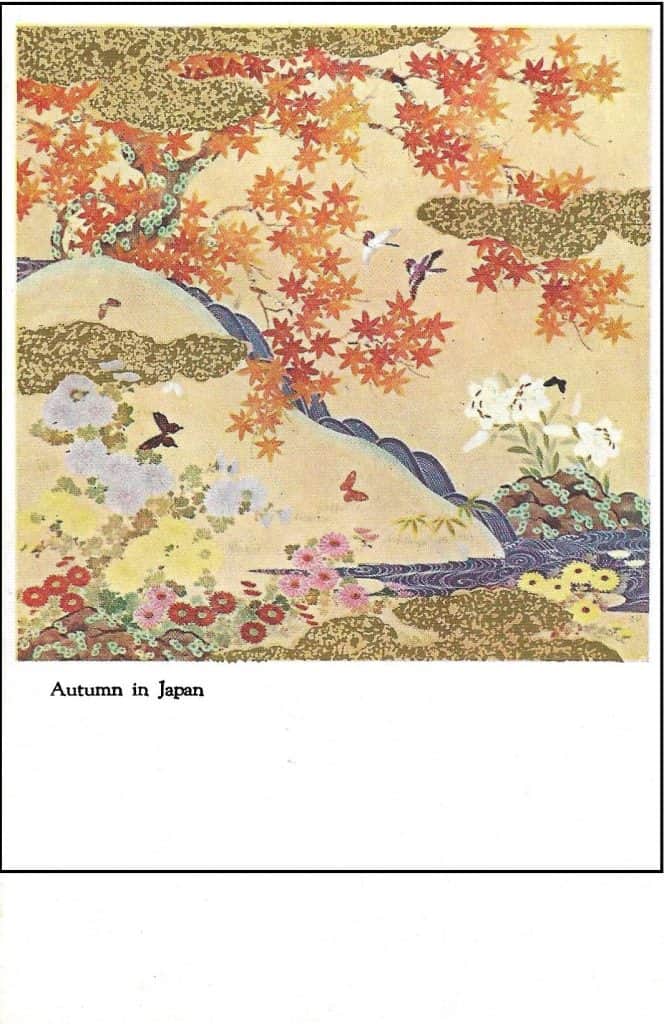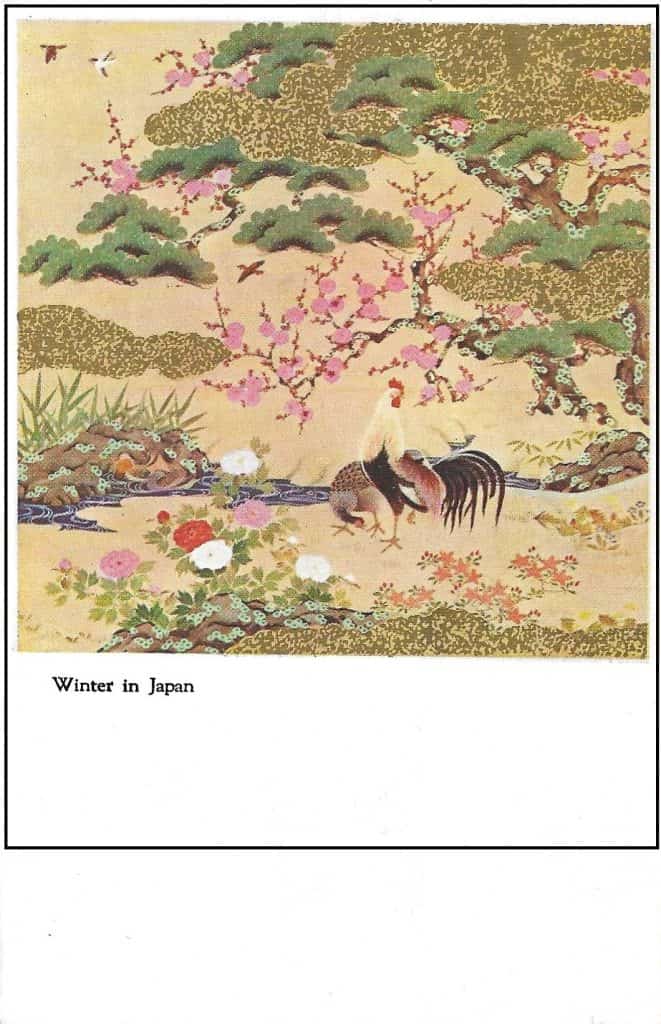It has been my pleasure to spend the last twenty months in the Land of the Rising Sun – Japan. This poetic name comes from the belief that Japan is the first country the Sun rises over when a new day begins in Asia’s far East.
Part of my work is societal analysis and how it is changing in this world of fast technological advancement and the apparent decline and/or enhancement of financial, ecological, and educational practices. It all sounds pretty fancy but in reality, most of my days are spent watching people – their habitual behavior, deeds, and conduct.
My postcard collection has suffered a great loss in the past year from lack of addition. However, these four cards of the Seasons in Japan are special and deserve to be shared.
***
Japan is a land of extraordinary natural beauty, and the four seasons offer rich cultural traditions that are deeply woven into the fabric of the Asian environment. Each season brings its own unique festivals, customs, and practices that reflect the much-admired harmony that exists in Japanese society. The seasonal rhythms are celebrated through food, clothing, art, and religious observances.

Spring: Hanami and Renewal
Spring in Japan is marked by the blooming of cherry blossoms (sakura), which usually occurs from late March to early April. This phenomenon is celebrated through hanami, or flower-viewing parties, where families and friends gather under the flowering trees to enjoy picnics, drink sake, and appreciate the fleeting beauty of the blossoms. The act of observing sakura is more than just appreciating aesthetics; it symbolizes the transient nature of life, encapsulated in the Japanese concept of “mono no aware,” which translates to the awareness that all life ends.
Apart from hanami, several traditional festivals take place in spring, such as the Hina Matsuri, or Doll Festival, which is celebrated in March. Families display decorative dolls that represent the Emperor, Empress, and their court, aimed toward a wish for the health and happiness of young girls. The rituals of spring encapsulate themes of renewal as the country emerges from the harshness of winter.

Summer: Matsuri and Resilience
As the heat of summer sets in, Japan bursts into life with colorful festivals called matsuri. These vibrant events, often held in July and August, involve processions, traditional dances, and fireworks. One of the most famous summer festivals is the Gion Matsuri in Kyoto, which runs throughout July and culminates in elaborate parades featuring floats and marchers.
Summer is also marked by bon-odori, a traditional dance performed to honor the spirits of ancestors during Obon, a Buddhist festival held in mid-August. Families return to their hometowns to pay respects at gravesites, and the dances are ways of inviting the spirits of their deceased relatives to be remembered.
In addition to festivals, summer foods such as eel (unagi) are popular, believed to impart strength and vitality. Seasonal ingredients, including fresh fruits like watermelon and the use of cooling techniques in architecture (like tatami mats and shoji screens), reflect a cultural adaptability to the summer heat.

Autumn: Harvest and Reflection
The Autumn foliage brings a canvas of vibrant color. This season is commonly celebrated for the harvest, often expressed in the tradition of “tsukimi,” or moon-viewing, which occurs in mid-September. Families prepare offerings of rice dumplings (dango) to honor the moon, a time-honored agricultural practice steeped in gratitude for the harvest.
Another significant event is the Matsuri of the autumn moon, where regional festivals abound, showcasing local culture through traditional plays, music, and food. The changing landscape also inspires various forms of art, notably literature and painting, reflecting the Japanese connection to nature and the cycle of life.
Autumn’s rich produce – chestnuts and persimmons – help celebrate culinary traditions. The family chefs are allowed to create dishes that feature seasonal flavors.

Winter: Solitude and Celebration
Winter casts a serene spell over the country, landscapes transform into blank slates. The season is punctuated by the celebration of the New Year (Shōgatsu), one of the most important holidays in Japan.
During Shōgatsu entire communities engage in customs such as preparing special foods (osechi), and sending New Year’s greetings (nengajō) to friends and relatives.
Shōgatsu celebrations often include visiting shrines for the first prayer of the year (hatsumode), where people seek blessings and fortunes. The legends surrounding this time emphasize renewal and hope, echoing themes established in spring. Additionally, winter festivals around the country, such as the Sapporo Snow Festival, exhibit ice sculptures and unique traditions that celebrate the beauty of winter.
Despite the cold weather, winter brings warmth through neighborhood gatherings, such as enjoying hot pot meals (nabe) with family and friends. The nation’s natural and fabricated hot springs (onsen) become popular in winter for the relaxation they offer. showcasing Japan’s cultural affinity for communal baths as a space for peace and tranquility.
Across Japan, the changing seasons are not just markers of time but profound influences on cultural identity and traditions. The balance between nature and human experiences is celebrated and appreciated.
Lovely article on a very unique and special country, thank you. I think you have done a great job capturing the seasons. For years I have been collecting pre WWII Japanese postcards with inset depictions of marus[ships]. Always enjoy seeing Japanese postcards celebrated.
When I was in kindergarten, I learned in class about the kite festival, which is held in May and coincides with Children’s Day.
Beautiful cards and well-told story. Japanese postcards are always interesting.